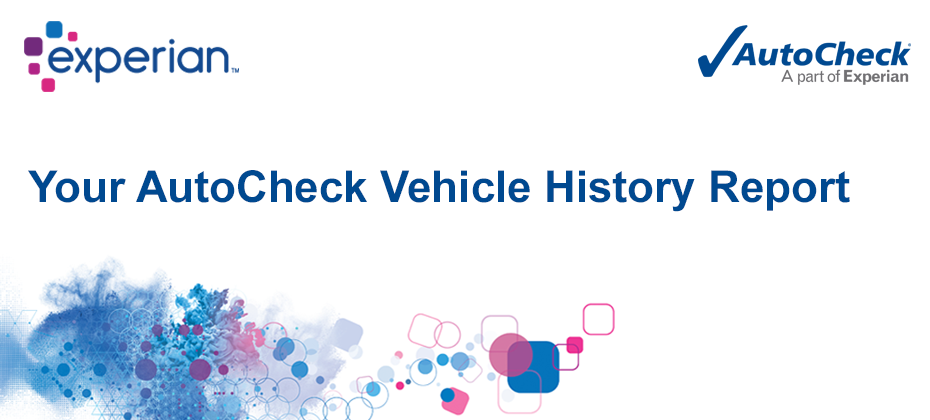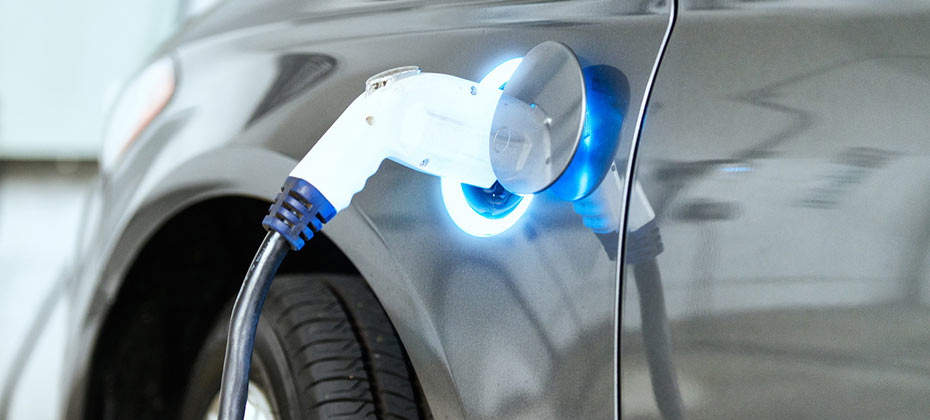
Automotive Blog
Welcome to the Experian Automotive Blog. Keep current on best practices and trending topics for the Auto industry.

Today, we’re excited to announce that AutoCheck® has received a facelift! AutoCheck has always been the industrial strength Vehicle History Report that automotive professionals trust to help manage risk and confidently buy and sell the right vehicles. We’ve made this great tool even greater by adding more data and accident insights than ever before and improving the user experience by making it easier to read across all mobile devices. Among the data and insights updated within AutoCheck: Updated display of how buyback protection details are presented Vehicle ownership history presentation Vehicle use history details Updated accident and damage check sections Updated display of how title brand information is displayed Updated odometer check Open safety recall information, inspection, service and repair history checks Based on extensive research, we’ve added many visual changes which make it easier for dealers and cars shoppers to understand and use the full report. One noticeable change is the addition of the Experian logo and color scheme. Experian continues to invest significantly in building a widely recognized and trusted brand. Reinforcing that AutoCheck is backed by Experian’s rich data and industry expertise will resonate with consumers as they look for a trusted source to confidently move along their vehicle shopping journey. The AutoCheck Score® has a new visualization, designed after an automotive-themed gauge to illustrate if the vehicle’s AutoCheck Score is below, within or above the score range for similar vehicles. Making the score easier to use and understand will help consumers better compare their vehicle to other similar vehicles currently in the market. We’ve also made the report easier to use and access for both consumers and dealers. AutoCheck is now optimized for tablet and mobile users, providing even more shopping convenience for users. As always, dealers can access the new report via AutoCheck Fast Link℠ for their online vehicle listings and through multiple integrations within their DMS or inventory management solution. The report will still be available directly from AutoCheck.com for consumers and AutoCheck.com/members for dealers. In addition, the report is available through most dealer platforms and all premier consumer automotive portals. Check out the full report redesign changes, updates and some additional highlights below. Updated AutoCheck® Buyback Protection Information As always, AutoCheck will buy back your vehicle if your AutoCheck report fails to list certain title brands available to Experian at the time the report was issued. Items impacting Buyback protection are now grouped together, so users can clearly see what data impacts Buyback qualification. Items that do not impact Buyback are captured in other areas of the report. Buyback Protection badging for eligible clients displays on the first page as well as in the specific State Title Brand section if the vehicle is, or is not, Buyback protected. NEW: Owner History AutoCheck now displays information for the current, last and previous vehicle ownership. The report will now highlight the year and state the vehicle was purchased from as well as the ownership date ranges and length of ownership. NEW: Vehicle Usage AutoCheck now clearly highlights the historical usage activity level for the vehicle, whether it was used as Personal, Fleet, Rental, Lease, Taxi, Livery, Police, Government, Drivers Ed and/or Commercial. NEW: Damage Check Section We have added a new Damage Check section to more clearly illustrate the historical activity for the vehicle. The Damage Check section will highlight damage records from auctions, salvage, or independent sources such as recycling and crash tests. We will continue to offer the Accident Check section, which highlights accident dates and location from government sources and independent agencies. The Damage Check section will highlight damage records from auctions, salvage auctions or independent sources such as recycling and crash tests. Other Title Brand and Specific Event check: Other title brands that are not included in Buyback protection qualification will be listed here. In addition, event activity such as theft and insurance loss is also included in this section. UPDATED: Odometer Check We have combined information to provide one place for all odometer related history checks. State title odometer check reflects all odometer related brands from the state such as Exceeds Mechanical Limits (EML), Not Actual Mileage (NAM) and Broken Odometer (BRK). Auction odometer check are the odometer brands either reported to auctions or upon inspection in auction announcements. The odometer calculation check is Experian’s proprietary odometer sequence calculation to determine if there are any potential discrepancies. NEW: ‘Check’ sections: To highlight specific data for easier reference and understanding, we have added an open safety recall check, Inspection history check, and service and repair history check section. What do all these changes mean for dealers and their customers? They have an easier-to-use AutoCheck VHR with more comprehensive information than ever. For dealers, it will help with their buying decisions at auction or on trade-ins. For consumers, it provides even more peace of mind when making a used vehicle purchase decision. Ultimately, it improves the shopping process for everyone involved and can help dealers develop even stronger relationships with their customers. Want to learn even more about AutoCheck? Visit our site for more details: https://www.experian.com/lp/automotive/autocheck-dealer-lp

Auto dealers need to move their dealerships forward through hyper-local advertising that helps them connect with the right audiences at the right time.

Subprime originations hit the lowest overall share of the market seen in 11 years, but does that mean people are being locked out car ownership? Not necessarily, according to the Q3 State of the Automotive Finance Market report.To gain accurate insights from the vast amount of data available, it’s important to look at the entire picture that is created by the data. The decrease in subprime originations is due to many factors, one of which being that credit scores are increasing across the board (average is now 717 for new and 661 for used), which naturally shifts more consumers into the higher credit tiers. Loan origination market share are just one of the trends seen in this quarter’s report. Ultimately, examining the data can help inform lenders and help them make the right lending decisions. Exploring options for affordability While consumers analyze different possibilities to ensure their monthly payments are affordable, leasing is one of the more reasonable options in terms of monthly payments. In fact, the difference between the average new lease payment and new car payment usually averages more $100—and sometimes well over—which is a significant amount for the average American budget. In fact, leases of new vehicles are hovering around 30 percent, which is one of the factors that is aiding in new car sales. In turn, this then helps the used-vehicle market, as the high number of leases create a larger supply of quality use vehicles when they come off-lease and make their way back into the market. On-time payments continue to improve As consumer preferences continue to trend towards more expensive vehicles, such as crossovers, SUVs, and pickups, affordability will continue to be a topic of discussion. But consumers appear to be managing the higher prices, as in addition to the tactics mentioned above, 30- and 60-day delinquency rates declined since Q3 2017, from 2.39 percent to 2.23 percent and 0.76 percent to 0.72 percent, respectively. The automotive finance market is one where the old saying “no news is good news” continues to remain true. While there aren’t significant changes in the numbers quarter over quarter, this signals that the market is at a good place in its cycle. To learn more about the State of the Automotive Finance Market report, or to watch the webinar, click here.

Your model is only as good as your data, right? Actually, there are many considerations in developing a sound model, one of which is data. Yet if your data is bad or dirty or doesn’t represent the full population, can it be used? This is where sampling can help. When done right, sampling can lower your cost to obtain data needed for model development. When done well, sampling can turn a tainted and underrepresented data set into a sound and viable model development sample. First, define the population to which the model will be applied once it’s finalized and implemented. Determine what data is available and what population segments must be represented within the sampled data. The more variability in internal factors — such as changes in marketing campaigns, risk strategies and product launches — and external factors — such as economic conditions or competitor presence in the marketplace — the larger the sample size needed. A model developer often will need to sample over time to incorporate seasonal fluctuations in the development sample. The most robust samples are pulled from data that best represents the full population to which the model will be applied. It’s important to ensure your data sample includes customers or prospects declined by the prior model and strategy, as well as approved but nonactivated accounts. This ensures full representation of the population to which your model will be applied. Also, consider the number of predictors or independent variables that will be evaluated during model development, and increase your sample size accordingly. When it comes to spotting dirty or unacceptable data, the golden rule is know your data and know your target population. Spend time evaluating your intended population and group profiles across several important business metrics. Don’t underestimate the time needed to complete a thorough evaluation. Next, select the data from the population to aptly represent the population within the sampled data. Determine the best sampling methodology that will support the model development and business objectives. Sampling generates a smaller data set for use in model development, allowing the developer to build models more quickly. Reducing the data set’s size decreases the time needed for model computation and saves storage space without losing predictive performance. Once the data is selected, weights are applied so that each record appropriately represents the full population to which the model will be applied. Several traditional techniques can be used to sample data: Simple random sampling — Each record is chosen by chance, and each record in the population has an equal chance of being selected. Random sampling with replacement — Each record chosen by chance is included in the subsequent selection. Random sampling without replacement — Each record chosen by chance is removed from subsequent selections. Cluster sampling — Records from the population are sampled in groups, such as region, over different time periods. Stratified random sampling — This technique allows you to sample different segments of the population at different proportions. In some situations, stratified random sampling is helpful in selecting segments of the population that aren’t as prevalent as other segments but are equally vital within the model development sample. Learn more about how Experian Decision Analytics can help you with your custom model development needs.

There are four reasons why the auto industry should be enthusiastic about the electric vehicle segment’s future.

Where are electric vehicles most popular? During the first half of the year, 3.6 percent of all new registrations in California were EVs.

In 2011, data scientists and credit risk managers finally found an appropriate analogy to explain what we do for a living. “You know Moneyball? What Paul DePodesta and Billy Beane did for the Oakland A’s, I do for XYZ Bank.” You probably remember the story: Oakland had to squeeze the most value out of its limited budget for hiring free agents, so it used analytics — the new baseball “sabermetrics” created by Bill James — to make data-driven decisions that were counterintuitive to the experienced scouts. Michael Lewis told the story in a book that was an incredible bestseller and led to a hit movie. The year after the movie was made, Harvard Business Review declared that data science was “the sexiest job of the 21st century.” Coincidence? The importance of data Moneyball emphasized the recognition, through sabermetrics, that certain players’ abilities had been undervalued. In Travis Sawchik’s bestseller Big Data Baseball: Math, Miracles, and the End of a 20-Year Losing Streak, he notes that the analysis would not have been possible without the data. Early visionaries, including John Dewan, began collecting baseball data at games all over the country in a volunteer program called Project Scoresheet. Eventually they were collecting a million data points per season. In a similar fashion, credit data pioneers, such as TRW’s Simon Ramo, began systematically compiling basic credit information into credit files in the 1960s. Recognizing that data quality is the key to insights and decision-making and responding to the demand for objective data, Dewan formed two companies — Sports Team Analysis and Tracking Systems (STATS) and Baseball Info Solutions (BIS). It seems quaint now, but those companies collected and cleaned data using a small army of video scouts with stopwatches. Now data is collected in real time using systems from Pitch F/X and the radar tracking system Statcast to provide insights that were never possible before. It’s hard to find a news article about Game 1 of this year’s World Series that doesn’t discuss the launch angle or exit velocity of Eduardo Núñez’s home run, but just a couple of years ago, neither statistic was even measured. Teams use proprietary biometric data to keep players healthy for games. Even neurological monitoring promises to provide new insights and may lead to changes in the game. Similarly, lenders are finding that so-called “nontraditional data” can open up credit to consumers who might have been unable to borrow money in the past. This includes nontraditional Fair Credit Reporting Act (FCRA)–compliant data on recurring payments such as rent and utilities, checking and savings transactions, and payments to alternative lenders like payday and short-term loans. Newer fintech lenders are innovating constantly — using permissioned, behavioral and social data to make it easier for their customers to open accounts and borrow money. Similarly, some modern banks use techniques that go far beyond passwords and even multifactor authentication to verify their customers’ identities online. For example, identifying consumers through their mobile device can improve the user experience greatly. Some lenders are even using behavioral biometrics to improve their online and mobile customer service practices. Continuously improving analytics Bill James and his colleagues developed a statistic called wins above replacement (WAR) that summarized the value of a player as a single number. WAR was never intended to be a perfect summary of a player’s value, but it’s very convenient to have a single number to rank players. Using the same mindset, early credit risk managers developed credit scores that summarized applicants’ risk based on their credit history at a single point in time. Just as WAR is only one measure of a player’s abilities, good credit managers understand that a traditional credit score is an imperfect summary of a borrower’s credit history. Newer scores, such as VantageScore® credit scores, are based on a broader view of applicants’ credit history, such as credit attributes that reflect how their financial situation has changed over time. More sophisticated financial institutions, though, don’t rely on a single score. They use a variety of data attributes and scores in their lending strategies. Just a few years ago, simply using data to choose players was a novel idea. Now new measures such as defense-independent pitching statistics drive changes on the field. Sabermetrics, once defined as the application of statistical analysis to evaluate and compare the performance of individual players, has evolved to be much more comprehensive. It now encompasses the statistical study of nearly all in-game baseball activities. A wide variety of data-driven decisions Sabermetrics began being used for recruiting players in the 1980’s. Today it’s used on the field as well as in the back office. Big Data Baseball gives the example of the “Ted Williams shift,” a defensive technique that was seldom used between 1950 and 2010. In the world after Moneyball, it has become ubiquitous. Likewise, pitchers alter their arm positions and velocity based on data — not only to throw more strikes, but also to prevent injuries. Similarly, when credit scores were first introduced, they were used only in originations. Lenders established a credit score cutoff that was appropriate for their risk appetite and used it for approving and declining applications. Now lenders are using Experian’s advanced analytics in a variety of ways that the credit scoring pioneers might never have imagined: Improving the account opening experience — for example, by reducing friction online Detecting identity theft and synthetic identities Anticipating bust-out activity and other first-party fraud Issuing the right offer to each prescreened customer Optimizing interest rates Reviewing and adjusting credit lines Optimizing collections Analytics is no substitute for wisdom Data scientists like those at Experian remind me that in banking, as in baseball, predictive analytics is never perfect. What keeps finance so interesting is the inherent unpredictability of the economy and human behavior. Likewise, the play on the field determines who wins each ball game: anything can happen. Rob Neyer’s book Power Ball: Anatomy of a Modern Baseball Game quotes the Houston Astros director of decision sciences: “Sometimes it’s just about reminding yourself that you’re not so smart.”

While electric vehicles remain a relatively niche part of the market, with only 0.9 percent of the total vehicle registrations through June 2018, consumer demand has grown quite significantly over the past few years. As I mentioned in a previous blog post, electric vehicles held just 0.5 percent in 2016. Undoubtedly, manufacturers and retailers will look to capitalize on this growing segment of the population. But, it’s not enough to just dig into the sales number. If the automotive industry really wants to position itself for success, it’s important to understand the consumers most interested in electric vehicles. This level of data can help manufacturers and retailers make the right decisions and improve the bottom line. Based on our vehicle registration data, below is detailed look into the electric vehicle consumer. Home Value Somewhat unsurprisingly, the people most likely to purchase an electric vehicle tend to own more expensive homes. Consumers with homes valued between $450,000-$749,000 made up 25 percent of electric vehicle market share. And, as home values increase, these consumers still make up a significant portion of electric vehicle market. More than 15 percent of the electric vehicle market share was made up by those with homes valued between $750,000-$999,000, and 22.5 percent of the share was made up by those with home values of more than $1 million. In fact, consumers with home values of more than $1 million are 5.9 times more likely to purchase an electric vehicle than the general population. Education Level Breaking down consumers by education level shows another distinct pattern. Individuals with a graduate degree are two times more likely to own an electric vehicle. Those with graduate degrees made up 28 percent of electric vehicle market share, compared to those with no college education, which made up just 11 percent. Consumer Lifestyle Segmentation Diving deeper into the lifestyles of individuals, we leveraged our Mosaic® USA consumer lifestyle segmentation system, which classifies every household and neighborhood in the U.S. into 71 unique types and 19 overachieving groups. Findings show American Royalty, who are described as wealthy, influential couples and families living in prestigious suburbs, led the way with a 17.8 percent share. Following them were Silver Sophisticates at 11.9 percent. Those in this category are described as mature couples and singles living an upscale lifestyle in suburban homes. Rounding out the top three were Cosmopolitan Achiever, described as affluent middle-aged and established couples and families who enjoy a dynamic lifestyle in metro areas. Their share was 10.1 percent. If manufacturers and retailers go beyond just the sales figures, a clearer picture of the electric vehicle market begins to form. They have an opportunity to understand that wealthier, more established individuals with higher levels of education and home values are much more likely to purchase electric vehicles. While these characteristics are consistent, the different segments represent a dynamic group of people who share similarities, but are still at different stages in life, leading different lifestyles and have different needs. As time wears on, the electric vehicle segment is poised for growth. If the industry wants to maximize its potential, they need to leverage data and insights to help make the right decisions and adapt to the evolving marketplace.

Electric vehicles are here to stay – and will likely gain market share as costs reduce, travel ranges increase and charging infrastructure grows.

Vehicle prices are going up, yet consumers seem unfazed. Despite consumers taking out larger loan amounts, they continue to make their monthly payments on time. But, affordability remains a point of industry interest. As vehicle prices hit record highs, how long will consumers have an appetite for them? According to Experian’s latest State of Automotive Finance Market report, delinquency rates continued a downward trend, as 30- and 60-day delinquencies were 2.11 and 0.64 percent, respectively, at the end of Q2. Those numbers demonstrate that car owners are making timely payments despite rising vehicle costs, which is an encouraging sign for the market. The average loan amount for a new vehicle is now $30,958, a $724 increase from last year. Additionally, consumers are now making monthly payments of about $525 on a new car loan, an all-time high that has seen a $20 year over year increase. The auto market shows little to no sign of declining costs, but vehicles aren’t the only cost to consider – interest rates have increased by 56 basis points since last year. When combined with the rising manufacturer costs, long-term affordability is a continued concern within the industry. The data points to consumers offsetting the expense by taking out longer loan terms. In Q2, the most common loan length was 72 months—which equates to six years—for both new and used financing. While this lowers the monthly payment, it leaves them subject to paying higher interest over time, as well as the potential for individuals to be upside down on their loan for a longer period of time. The key takeaway from this data is that costs continue to rise, but consumers appear to be doing a better job of managing their finances. This insight can help OEMs, dealers, and lenders make strategic decisions with a better understanding of consumer borrowing and credit habits, and think about how to make car ownership more inviting, through incentive or loyalty programs. For consumers, continuing to take steps to actively improve your credit score is one of the key ways to ensure that you’re able to negotiate the right deal when it comes to financing. Ultimately, for everyone involved, it comes down to leveraging the power of data to make more informed decisions, which can help make vehicle ownership more accessible and affordable. To learn more about the State of the Automotive Finance Market report, or to watch the webinar, click here.

In the aftermath of Hurricane Florence, Experian is here to help. As a first line of defense against purchasing a flood-damaged vehicle, people can download our free Vehicle Flood Risk Check app.

Trivia question: Millennials don’t purchase new vehicles. True or False?

When it comes to driving the automotive industry forward, Experian Automotive has a motto: “The right cars. The right customers. The right data to know the difference.” We deliver an integrated perspective based on the highest quality automotive information and market intelligence. Data is important to us, and we have the most robust combination of data assets under one roof. The North American Vehicle Database℠, File One℠ Credit Database, Consumer View℠ Marketing Database, Online Activity Databases, and National Fraud Database℠ all fed into Experian’s Auto HyperConnect™. Auto HyperConnect houses two different solutions: Auto HyperTargeting™ and Auto HyperMonitoring™. There are four different components to Auto HyperTargeting, and the one we will focus on today is Expired Lease. Dealers have found success marketing to their own customers when vehicle leases come due. The challenge has been conquesting off-lease consumers who didn’t buy from them. While off-lease consumer marketing lists are available, they only provide the estimated lease end date and monthly lease payment. When restricted to this data, it’s hard to tell if a $550 a month payment is for a Ford F150 or a BMW 3-series. And yet this is exactly the level of detail needed to successfully target off-lease marketing. Experian’s new Auto HyperTargeting- Expired Lease addresses this challenge by enabling dealers to identify and engage off-lease audiences through a highly targeted approach that has never been possible! Now, finding customers is much easier and cost-effective. You can use the best mix of selection criteria to maximize your off-lease conquesting strategy. Some of the ways you can identify your audience are: Lease Maturity Date Vehicle Make Vehicle Model Zip Code Model Performance Tier Distance from Dealer Ship Vehicle Status (New or Used) Signing up for Auto HyperTargeting- Expired Lease comes with five perks. The first is a monthly file. This includes name and address, lease maturity date, make/model, monthly payment bands, and phone and email address when available. The second is the ability to make sign up for a subscription monthly payments. Third is marketing flexibility with direct mail, email, and phone. Four there is no firm offer of credit required for this. Finally, a quarterly sales report. ARA reports provide sales metrics industry wide for your targets. Other competitive features also available in Auto HyperTargeting- Expired Lease is the customers full contact information with name, address, email address and phone number. And for online and offline channels, you can select a specific audience that is customizable. Auto HyperTargeting has some amazing features to successfully conquest customers, and Expired Lease is one of the four ways to do this. Stay tuned for Auto HyperTargeting- Vehicle Owners coming up next!

In our previous post, we talked about Experian’s 2018 Attribution Study. This study is a wide-ranging, dealer-focused sales-driven attribution study to answer the question of what drives sales. Three takeaways were formed and the first was looking at shopper behavior instead of isolated KPIs. Now, we look at the second and third takeaways. Optimize your paid advertising Paid search is an important part of dealership marketing and precise targeting will help with both traffic and purchasing rate. Branded search drives quality traffic to websites. 7% of all traffic and 12% of HVU traffic comes from branded search. Along with traffic, the purchase rate was found to be 54% higher than average. In terms of value, New Make and Model has impressive results. 2% of all traffic and 12% of HVU traffic comes from New Make and Model. The purchase rate is 137% higher than average. Of note, we found that in order to optimize paid search to drive sales, you must buy your own name. 100% of dealers studied had buyers via branded search. With that, optimized “New Make Model” campaigns are crucial. 82% of dealers had buyers come through Make Model keywords. Traditionally, New Make Model would just create a higher funnel but since we are in the digital age, this does not happen anymore. Some participating dealers spent <20% of search budget on New Make Model campaigns. A key point is that no dealer had buyers come through via competitors’ keywords. As for a dealer’s website, display leasing offers and content for buyers since many search queries contained lease keywords. Although paid search is important, there are other channels to optimize and segmentation is key. This study found that conquesting with bulk email-blasts is not effective. You can achieve better email marketing results by targeting shoppers more intelligently and using quality lists. CRM-driven loyalty campaigns performed well in this segment. Display campaigns revealed that social media is no longer just for posting content but paid social advertising campaigns were effective. In fact, this study found Facebook display to be more effective than Google and other display networks. The reason is it is easier to segment and target a specific audience through Facebook. Google is more difficult to segment and has too many set-it-and-forget-it campaigns. Evaluate your third-party investments This brings us to third-parties, such as Automotive Shopping Portals and other lead providers. Performance with third-parties can vary and dealers should evaluate third-party performance as it relates to your sales. The third-party buy rate was under-indexed for dealers versus all sales. The business model for third-parties is not focused on driving traffic to dealer sites. Since there are so many vehicles listed on third-party sites from franchises, independent dealers, and private parties, there is a lot of “noise” for customers to sift through. For dealers, finding out what drives sales has led to Experian's 2018 Attribution. Our wide-ranging, dealer focused sales-driven attribution study focused on key variables and delivers three recommendations: Focus on website shopper behavioral metrics to drive sales. optimize paid search, specifically branded search and new make model campaigns. and evaluate third-party performance as it relates to your sales. With these, a dealer can be more confidant with their marketing and their data.